20 stories, hundreds of images and many new friends and discoveries made for a highly successful NW Portland Week. Thank you for reading and contributing (I think the comment threads were as interesting and valuable as our reporting). And a special thanks goes to our 250 subscribers. Their monthly payments are what make these special reporting projects possible.
So, what did we learn?
We learned that northwest Portland has more potential when it comes to bike access investments than any other part of the city. And if you think those investments would only target “the rich” you might want to read Michael’s excellent story that debunked that myth.
Spending a week on our bikes in northwest also made it clear that this part of our city is growing rapidly. At times it felt like I couldn’t bike more than a few blocks without seeing chain-link fences and construction equipment. New office, retail and residential buildings are popping up everywhere from the already-dense inner Pearl District to the former industrial lots out on NW Naito.
It’s imperative that we get this growth right. We did it right once before 100 years ago during the northwest’s first apartment boom and now we’re getting a second chance.
Advertisement
The bad news is that if too many of these new residents hop in their cars the streets won’t work for anyone. The good news is that after over 15 years of neglect the City of Portland is finally poised to invest in more bike-friendly streets throughout the quadrant. And there’s one marquee project — the new Flanders Bridge — that could really move the needle.
With new greenways and (hopefully) a new crossing of I-405 at Flanders, all the beautiful people who bike to and from northwest will be much safer and happier.
Speaking of being happy, we had a great time capping off the week at our Get Together on Friday. It was fun to meet readers who followed the coverage and wanted to talk with other northwest Portland riders. Thanks to Corsa Cafe and Western Bikeworks for hosting. Here are a few more photos from the event…
And thanks again to all of you who read and contribute (both editorially and financially) to BikePortland. Our work is making a big impact and we can’t do it without your help.
Oh, and stay tuned… We’ve got one last story coming that we couldn’t quite finish up last week. A profile of Allan Classen, editor of the NW Examiner neighborhood newspaper.
— Jonathan Maus, (503) 706-8804 – jonathan@bikeportland.org
Our work is supported by subscribers. Please become one today. .


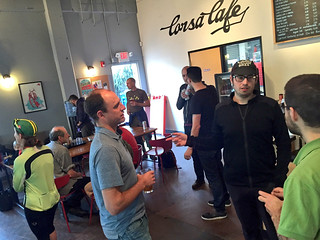
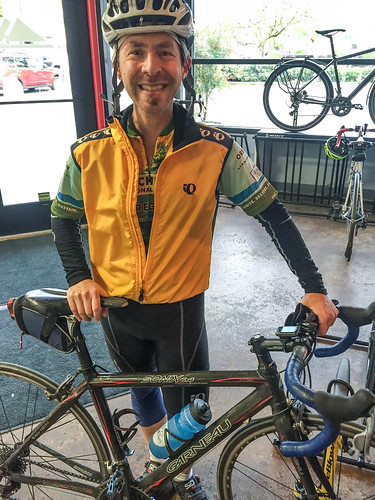
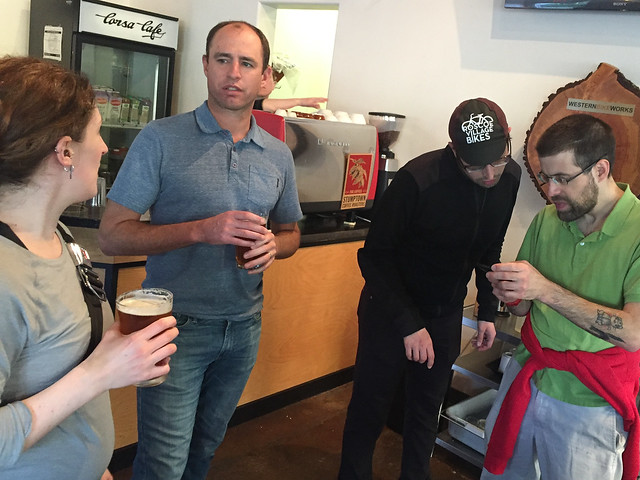
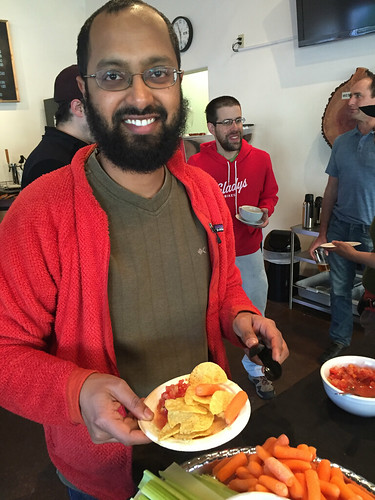
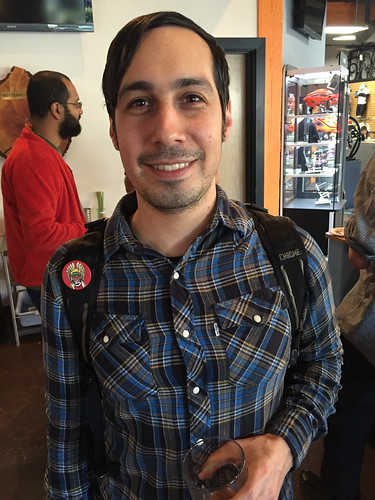
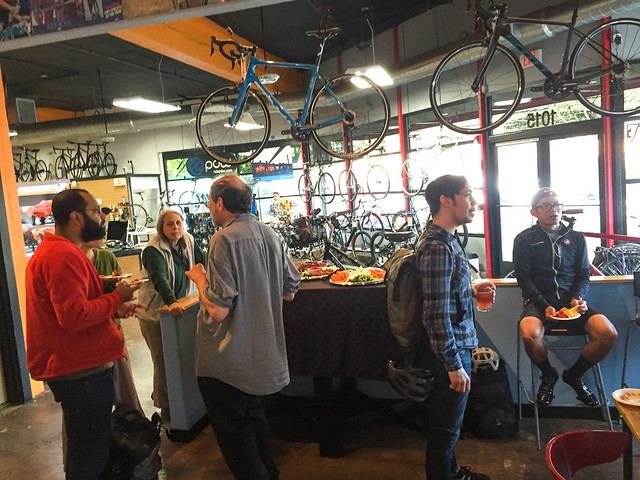
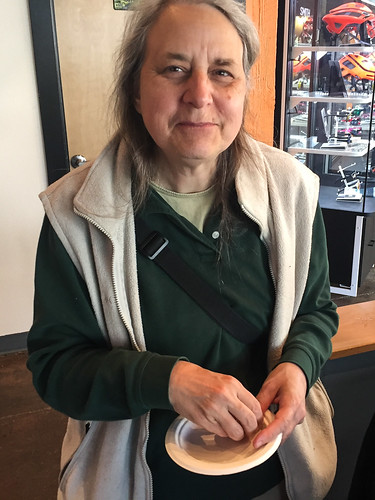

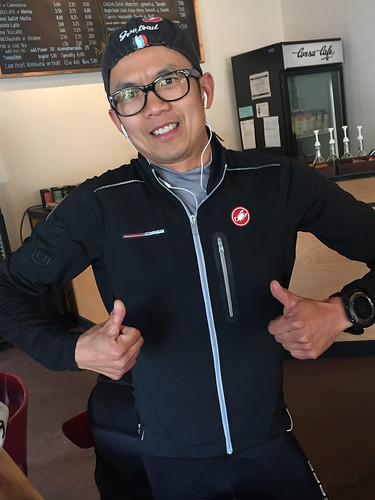

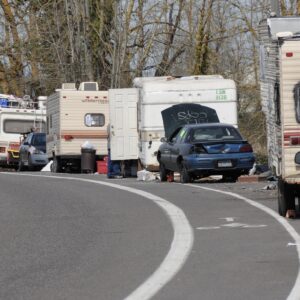
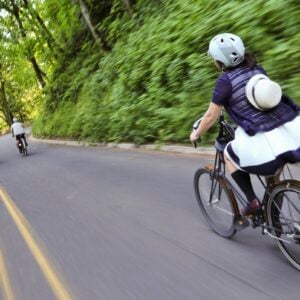
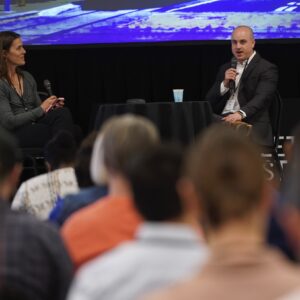
Thanks for reading.
BikePortland has served this community with independent community journalism since 2005. We rely on subscriptions from readers like you to survive. Your financial support is vital in keeping this valuable resource alive and well.
Please subscribe today to strengthen and expand our work.
I still do not see any advantages of “The Flanders bridge” except to give cycling a reputation of being totally obstructionist. The bridge would be directly between 2 Main freeway exits and entrances. It is also in the middle of 4 primary one way thoroughfares. One on each side. There are no signals to gain access to the Proposed Flanders bridge. The configuration of each of the one way thoroughfares puts the bridge the wrong way for access for cyclists is against the. Personally I would be very uncomfortable going the wrong way on any of these streets to gain access to the bridge since bike paths and access is one block away on the one way streets.
The Concrete barriers on each side of the freeway are not adequate for support of the bridge by dropping it onto the wall edges. I personally feel comfortable riding on either Everett or Glisten approaching or crossing the freeway. I do not feel comfortable going any more than one block on Flanders.
Any bridges, tunnels, caps, etc that work to re-connect the street grid that urban freeways destroyed in the 20th Century are worthy projects. This is as much a pedestrian project as it is a bike project.
Hi Tom,
I see the project as a carfree bridge that can connect two parts of northwest Portland that are currently severed by dangerous crossings and a major freeway.
And I agree with Chris that this shouldn’t be seen as a “bike bridge” because it’s really about making this part of town much better for people — instead of being a slave to people’s cars like Everett, Glisan and Couch currently are.
Sorry Jonathan, It is just that there is no sidewalk on the east side of 16th, only a rail with no break. There is no bike facility on the west side of 16th nor on Flanders.True there is a bike/bus zone 14 dfoot wid on the right side of Glisan. On 14th there is a bike lane on the east side of 14th but not on the west side. The 405 was put in in the 60’s but there are crossings for both cars, bikes and pedestrians every 2 blocks. A Flanders crossing for peds and cyclists is nearly as bad as a crossing at Irving up and over the freeway for peds and cyclists. The ramp would have to start at 18th. The east end of the ramp would be at 13th after tunneling through 2 newly built and rebuilt buildings.
One block away from Irving is Johnson. The only problem with Johnson is the homeless camping that has been going on there for the last 20 years.
Going the other way from Everett is Couch which has a bike friendly overpass and is also an entrance to the 405 northbound.
The engineers have all ready been over the structure needed to put up a Flanders bridge. It cannot be made of steel, concrete or wood. The structure would need to be similar to Tillicum. The difference would be Max nor Trimet would not be paying for it. combined with $2million + for additional traffic light infrastructure and the cost of the bridge and the 3 year construction project for the footings in the freeway divider. Plus the involvement by ODOT for that. Plus the additional $6 million for political meetings and consultants. It would be a folly to pursue it.
“It cannot be made of steel, concrete or wood. The structure would need to be similar to Tillicum (sic).”
Tilikum Crossing is made of steel and concrete. Where did you get your engineering degree, Tom?
I was talking of conventional structure like Hawthorne, Morrison, Sellwood, The Tillicum support structure is from the center pilings and through the cables. Not from the end/wall foundations.
BTW Stanford, not Twitter.
So your suggesting the only way to get to the proposed Flanders bridge when going East would be take Everett all the way to 405 and turn NB going the wrong way up 16th to Flanders? And the same when coming up to Glisan, you would only be able to turn SB and go the wrong way down 14th to Flanders? Gotcha.
Glisan has virtually no Bike facilities leading up to and crossing 405… unless you consider riding in the door zone or sharing a lane with a bus adequate.
I do the Everett and Glisan crossings at least twice a week on the bike. Never had a problem from 23rd to Naito. I have seldom ever been honked at either.
“There are no signals to gain access to the Proposed Flanders bridge.
The Concrete barriers on each side of the freeway are not adequate for support of the bridge by dropping it onto the wall edges.”
You make it sound like they will drop this thing from a helicopter and open it the next day. Do you honestly think the bridge will not be designed and constructed to be structurally sound, and include necessary traffic control modifications? If so, why do you think that will happen? If a Random Internet Commenter can pick up on that sort of detail, don’t you think the 2 dozen or so civil, structural and traffic engineers who will design and build this thing might also think of it?
But it won’t be inexpensive and you could get a heck of a lot of other bike infra for the cost of this single highway crossing.
The helecopter idea!!! That is what was originally proposed when Sam Adams proposed it for the section of the old Sauvis island bridge. When the engineers came back that the walls were not strong enough, that is when he decided to scrap the plan.
Urban myth but the easiest to explain to the public. For example, you can not just reuse steel in commercial structures, It has to be certified and come from a mill. The cost to certify and test existing stuff you want to reuse would cost more than just building from scratch. And that applies to commercial projects, the standards are higher for bridges. The idea of recycling the Sauvie Island bridge wasn’t going to work on so many levels it isn’t even funny. Recycling Helicopters….man that idea is so Portland cool, but it was a save face excuse for something that never would have worked.
As for the walls not holding the bridge, that too is ridiculous. Such a bridge would require either pylons or new footings or seismic slip connections. No one builds directly on retaining walls – ever. You don’t even need to break out the slide rule to figure that one out. Retaining walls are not designed for taking on the kind of static lateral load that a properly cambered bridge would place upon it (if it was designed as a full span bridge).
And the 3 year build time includes design, design voting, public comment, and all that other pre-build political bs. To build a 150′ x what 24′ bridge over the highway will likely be less than 6 months – most of that time likely tied up in shoring up the foundation. The steel and concrete will go extremely fast. For example, recently my iron working crew had an original schedule of two months for a 260′ x 45′ mezzanine – took about 4 months to finished cement pour mostly because of unforeseen problems with the original structure we were remodeling. We seldom had more than 3 people working on it. And on the bridge, there would be no unknowns once you got past the footings phase.
You could easily remove the trees on 15th and likely build most the entire span on the ground and set it in place with a two crane pick. As long as it was assembled on the ground correctly, it would take longer to set up the cranes than to pick the bridge and set it in place. I don’t work on bridges, so I can’t say for sure, but it really wouldn’t take that long. I did something similar with a 50′ x 6′ pedestrian sky bridge and it took one day to set up, and one day to weld it up and we were setting it on the third day, about another five leisurely days of only me welding on it (including the finishing work) and it was done.
And though as far as bicycle infrastructure goes, yeah I think there would be better places to use the money. However, in the case of a catastrophic earthquake, west of the 405 would be cut off from Downtown. All the other street crossings will collapse, and the ramps to the Freemont will likely crumble and collapse (though the rest of bridge will likely remain) between 15th and 16th north of Johnson which would nearly completely cut off NW Portland from the rest of the city (not that there’d be much left of it after the slides and liquefication of the ground anyway).
The earthquake aspect is a very good one. The city needs to think strategically about pedestrian and emergency vehicle connections. At least we now have a bridge on the Willamette that we know will be standing, and we need to think about our freeway trenches and viaducts. The Flanders bridge will be an important link.